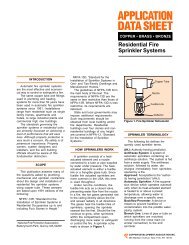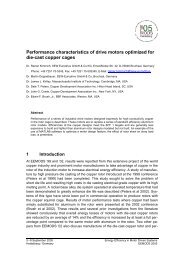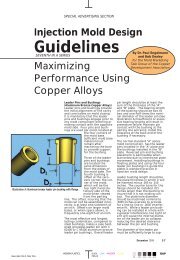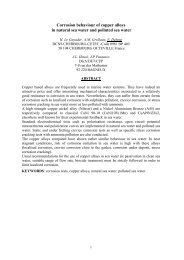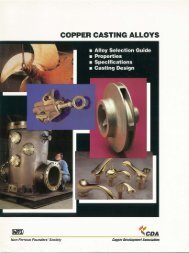Living with the threat of microbiologically influenced corrosion in ...
Living with the threat of microbiologically influenced corrosion in ...
Living with the threat of microbiologically influenced corrosion in ...
Create successful ePaper yourself
Turn your PDF publications into a flip-book with our unique Google optimized e-Paper software.
<strong>Liv<strong>in</strong>g</strong> <strong>with</strong> <strong>the</strong> <strong>threat</strong> <strong>of</strong> <strong>microbiologically</strong><br />
<strong><strong>in</strong>fluenced</strong> <strong>corrosion</strong> <strong>in</strong> submar<strong>in</strong>e seawater<br />
systems: The Royal Navy’s perspective<br />
G J E Nickl<strong>in</strong>, MSc, CEng, MIMechE<br />
UK M<strong>in</strong>istry <strong>of</strong> Defence<br />
SYNOPSIS<br />
Microbiologically Influenced Corrosion (MIC) has been recognised as a serious <strong>threat</strong> to both availability and safety<br />
<strong>in</strong> a number <strong>of</strong> <strong>in</strong>dustries for many decades, none more so than <strong>in</strong> <strong>the</strong> mar<strong>in</strong>e sector. The Royal Navy (RN) has<br />
suffered significant platform downtime <strong>in</strong> recent years as a result <strong>of</strong> MIC related defects <strong>in</strong> seawater cooled shell and<br />
tube heat exchangers, particularly <strong>in</strong> submar<strong>in</strong>es. The move to titanium, one <strong>of</strong> <strong>the</strong> few metals that appears to be<br />
resilient to this form <strong>of</strong> <strong>corrosion</strong>, has been an obvious and very successful solution to problems <strong>with</strong> smaller,<br />
removable tube stacks <strong>with</strong><strong>in</strong> surface ship mach<strong>in</strong>ery. For <strong>in</strong>-service submar<strong>in</strong>es, however, which extensively<br />
employ copper-nickel alloy tub<strong>in</strong>g, such a retr<strong>of</strong>it option could not be considered for a variety <strong>of</strong> reasons. As such,<br />
<strong>the</strong> UK MOD has had to exam<strong>in</strong>e a number <strong>of</strong> strategies to allow <strong>the</strong> cont<strong>in</strong>ued operation <strong>of</strong> submar<strong>in</strong>e heat<br />
exchangers <strong>in</strong> microbially hostile waters whilst m<strong>in</strong>imis<strong>in</strong>g <strong>the</strong> risk <strong>of</strong> MIC. Given <strong>the</strong> enormous f<strong>in</strong>ancial and<br />
operational consequences <strong>of</strong> a fur<strong>the</strong>r MIC event, extremely conservative short-term solutions have been adopted.<br />
These have <strong>in</strong>cluded <strong>the</strong> complete exclusion <strong>of</strong> dockyard water from heat exchangers whilst <strong>in</strong> upkeep, us<strong>in</strong>g a<br />
comb<strong>in</strong>ation <strong>of</strong> “sacrificial” <strong>in</strong>terface coolers, closed loop circulat<strong>in</strong>g rigs or even total loss fresh water. Interim<br />
solutions still be<strong>in</strong>g developed <strong>in</strong>clude <strong>the</strong> identification and deployment <strong>of</strong> cooler condition<strong>in</strong>g chemicals to make<br />
<strong>the</strong> system alloys more tolerant to microbial attack. F<strong>in</strong>ally, follow<strong>in</strong>g an exhaustive series <strong>of</strong> laboratory scale<br />
microbiological experiments and <strong>corrosion</strong> replication trials, work is now <strong>in</strong> progress to evaluate a number <strong>of</strong> water<br />
treatment options, such that <strong>the</strong> risk <strong>of</strong> contam<strong>in</strong>at<strong>in</strong>g vulnerable submar<strong>in</strong>e coolers <strong>with</strong> <strong>the</strong> bacteria cited <strong>in</strong> <strong>the</strong> MIC<br />
mechanism whilst <strong>in</strong> harbour can be m<strong>in</strong>imised.<br />
INTRODUCTION<br />
Copper-nickel alloys have been employed <strong>in</strong> seawater cooled systems for over half a century. Although orig<strong>in</strong>ally<br />
developed due to <strong>the</strong>ir resistance to <strong>corrosion</strong>, it was quickly established that copper alloys also exhibited excellent<br />
resilience to macr<strong>of</strong>oul<strong>in</strong>g, <strong>the</strong> size and extent <strong>of</strong> which could o<strong>the</strong>rwise disable flow through a heat exchanger <strong>with</strong><strong>in</strong> a<br />
matter <strong>of</strong> weeks 1 . Increas<strong>in</strong>g <strong>the</strong> nickel content improved <strong>the</strong> resistance <strong>of</strong> <strong>the</strong> alloy to imp<strong>in</strong>gement attack due to <strong>the</strong><br />
shear stresses <strong>of</strong> <strong>the</strong> water flow<strong>in</strong>g <strong>in</strong> <strong>the</strong> bore <strong>of</strong> <strong>the</strong> tube, allow<strong>in</strong>g greater seawater speeds to be employed and <strong>in</strong> turn<br />
reduc<strong>in</strong>g <strong>the</strong> size <strong>of</strong> <strong>the</strong> cooler for a given heat transfer rate. These features have allowed copper-30%nickel alloys<br />
(here on referred to as 70:30) to capture and reta<strong>in</strong> <strong>the</strong> vast majority <strong>of</strong> <strong>the</strong> submar<strong>in</strong>e heat exchanger market.<br />
Throughout this half-century period, it has been well established that <strong>the</strong> <strong>corrosion</strong> resistance <strong>of</strong>fered by copper-nickel<br />
alloys relies on <strong>the</strong> formation <strong>of</strong> a th<strong>in</strong>, tightly adherent, cuprous oxide surface that forms naturally upon exposure to<br />
clean, oxygenated seawater, nei<strong>the</strong>r <strong>of</strong> which can be taken as given for <strong>the</strong> seawater <strong>in</strong> a typical upkeep dockyard. By<br />
<strong>the</strong>ir very nature, dockyards tend to be located <strong>in</strong> estuar<strong>in</strong>e areas, or make use <strong>of</strong> non-tidal bas<strong>in</strong>s for <strong>the</strong> provision <strong>of</strong><br />
grav<strong>in</strong>g docks and ma<strong>in</strong>tenance berths. The stagnant conditions that such bas<strong>in</strong>s <strong>in</strong>evitably encourage lead to a high<br />
oxygen demand, allow<strong>in</strong>g anaerobic bacteria to thrive and for <strong>the</strong>ir metabolic by-products to accumulate. For<br />
vulnerable copper alloy tub<strong>in</strong>g (ei<strong>the</strong>r brand new or freshly cleaned and descaled), <strong>the</strong> most <strong>threat</strong>en<strong>in</strong>g <strong>of</strong> <strong>the</strong>se byproducts<br />
are sulphide ions produced by <strong>the</strong> group <strong>of</strong> sulphide generat<strong>in</strong>g bacteria. An oxide coat<strong>in</strong>g formed on <strong>the</strong><br />
surface <strong>of</strong> tub<strong>in</strong>g <strong>in</strong> <strong>the</strong> presence <strong>of</strong> sulphide contam<strong>in</strong>ation will be weak and brittle render<strong>in</strong>g it liable to greatly<br />
accelerated <strong>corrosion</strong> dur<strong>in</strong>g subsequent service, even follow<strong>in</strong>g return to nom<strong>in</strong>ally clean seawater. The process <strong>of</strong><br />
ensur<strong>in</strong>g that copper alloy receives an effective oxide coat<strong>in</strong>g prior to service is known as “condition<strong>in</strong>g”.<br />
Assum<strong>in</strong>g <strong>the</strong> material has been adequately conditioned, <strong>corrosion</strong> rates for copper alloys can be as little as 0.02<br />
mm/year (2) . Armed <strong>with</strong> <strong>the</strong> knowledge that condition<strong>in</strong>g is crucial, those authorities responsible for <strong>the</strong> refit and<br />
Author’s Biography<br />
Lt Gareth Nickl<strong>in</strong> is currently <strong>the</strong> submar<strong>in</strong>e projects eng<strong>in</strong>eer for <strong>the</strong> steam propulsion support desk <strong>of</strong> <strong>the</strong> UK MOD. Prior to<br />
jo<strong>in</strong><strong>in</strong>g <strong>the</strong> section <strong>in</strong> October 2006, he completed a 4-year tour as an eng<strong>in</strong>eer <strong>of</strong>ficer <strong>in</strong> <strong>the</strong> nuclear powered ballistic missile<br />
submar<strong>in</strong>e HMS VIGILANT. Lt Nickl<strong>in</strong> has ga<strong>in</strong>ed a master’s degree <strong>in</strong> mar<strong>in</strong>e electrical eng<strong>in</strong>eer<strong>in</strong>g whilst <strong>in</strong> <strong>the</strong> service and is a<br />
member <strong>of</strong> <strong>the</strong> Institute <strong>of</strong> Mechanical Eng<strong>in</strong>eers.
ma<strong>in</strong>tenance <strong>of</strong> UK submar<strong>in</strong>es have, <strong>in</strong> <strong>the</strong> past, been successful <strong>in</strong> ensur<strong>in</strong>g that heat exchangers meet <strong>the</strong>ir design life<br />
<strong>in</strong>tent. In <strong>the</strong> current decade, however, a move to reduce <strong>the</strong> length <strong>of</strong> ma<strong>in</strong>tenance periods, toge<strong>the</strong>r <strong>with</strong> pressures on<br />
resource and f<strong>in</strong>ance have slowly lead to <strong>the</strong> demise <strong>of</strong> <strong>the</strong> care and attention that was once afforded to <strong>the</strong>se<br />
components. Whilst it is apparent that no formal condition<strong>in</strong>g procedure was ever strictly adhered to, it is clear from<br />
<strong>the</strong> literature that coolers were afforded some protection, largely on an ad-hoc basis. In some cases this was achieved<br />
by circulat<strong>in</strong>g clean seawater imported by barge through <strong>the</strong> new cooler, <strong>in</strong> o<strong>the</strong>r cases ma<strong>in</strong>s fresh water has been used.<br />
Regardless <strong>of</strong> how it was achieved, <strong>the</strong> condition<strong>in</strong>g process took time. For those look<strong>in</strong>g to shorten <strong>the</strong> programme it<br />
was an <strong>in</strong>evitable target, and for submar<strong>in</strong>es enter<strong>in</strong>g upkeep periods <strong>in</strong> 2005 and 2006, it was seen as a luxury which<br />
could easily be removed from <strong>the</strong> package. Such a decision meant submar<strong>in</strong>e coolers would now experience <strong>the</strong>ir first<br />
seawater exposure <strong>with</strong> water from a non-tidal bas<strong>in</strong> and as such become vulnerable to MIC attack. In <strong>the</strong> space <strong>of</strong> a<br />
year, <strong>the</strong> submar<strong>in</strong>e flotilla lost a total <strong>of</strong> 8-months operational availability across 2 platforms as a result <strong>of</strong> rampant<br />
pitt<strong>in</strong>g <strong>corrosion</strong> 3 . The first pit to breach through a tube wall occurred after just 6-months <strong>of</strong> service, an overall<br />
<strong>corrosion</strong> rate <strong>of</strong> 2 mm/year (Fig 1).<br />
Fig 1 View along bore <strong>of</strong> failed cooler tube (7/16 <strong>in</strong>ch OD) show<strong>in</strong>g through wall pit<br />
This paper reviews <strong>the</strong> actions taken by <strong>the</strong> UK MOD <strong>in</strong> light <strong>of</strong> <strong>the</strong> lessons learnt from <strong>the</strong>se MIC events, from <strong>the</strong><br />
immediate response to exclude all suspect bas<strong>in</strong> waters from vulnerable coolers and to re-educate <strong>the</strong> community on <strong>the</strong><br />
importance <strong>of</strong> condition<strong>in</strong>g, through to <strong>the</strong> formulation <strong>of</strong> longer term solutions, <strong>in</strong>clud<strong>in</strong>g studies <strong>with</strong> chemical<br />
<strong>corrosion</strong> <strong>in</strong>hibitors and water treatment technologies.<br />
BACKGROUND<br />
Bi<strong>of</strong>oul<strong>in</strong>g on <strong>the</strong> <strong>in</strong>crease<br />
The turn <strong>of</strong> <strong>the</strong> century saw <strong>the</strong> UK submar<strong>in</strong>e force <strong>in</strong>creas<strong>in</strong>gly deployed to <strong>the</strong> littoral and to warmer and shallower<br />
waters, as opposed to <strong>the</strong>ir previous ‘cold war’ operat<strong>in</strong>g areas <strong>in</strong> <strong>the</strong> North Atlantic. This new environment, rich <strong>in</strong><br />
mar<strong>in</strong>e life and organisms, led to vastly <strong>in</strong>creased occurrences <strong>of</strong> cooler blockage by bi<strong>of</strong>oul such as crustaceans and sea<br />
grass (Fig 2 & 3).<br />
Fig 2 Severely fouled submar<strong>in</strong>e cooler outlet header and tubeplate follow<strong>in</strong>g deployment (tubeplate diameter 850mm)
Fig 3 As Fig 2 – detail on <strong>in</strong>let tubeplate <strong>with</strong> only a small number <strong>of</strong> tube <strong>in</strong>lets clear<br />
This was much to <strong>the</strong> surprise <strong>of</strong> <strong>the</strong> scientific community who have always considered copper based systems to be<br />
immune to macr<strong>of</strong>oul<strong>in</strong>g. The reality was, however, that submar<strong>in</strong>es deployed on operations were suffer<strong>in</strong>g limitations<br />
to mach<strong>in</strong>ery, or worse, return<strong>in</strong>g to port <strong>in</strong> order to strip heat exchangers such that tube blockages could be cleared.<br />
Reduction <strong>in</strong> heat exchange is not <strong>the</strong> only issue surround<strong>in</strong>g foul<strong>in</strong>g, choked flow <strong>in</strong> blocked tubes will lead to higher<br />
seawater velocities <strong>in</strong> clear tubes, result<strong>in</strong>g <strong>in</strong> higher rates <strong>of</strong> erosion, stripp<strong>in</strong>g <strong>the</strong> oxide coat<strong>in</strong>g from <strong>the</strong> tube wall and<br />
render<strong>in</strong>g it vulnerable to pitt<strong>in</strong>g <strong>corrosion</strong>.<br />
The process <strong>of</strong> dismantl<strong>in</strong>g a submar<strong>in</strong>e cooler to facilitate mechanical clean<strong>in</strong>g is lengthy, expensive and extremely<br />
disruptive to adjacent equipment. Extensive system pressure test<strong>in</strong>g is fur<strong>the</strong>rmore required follow<strong>in</strong>g re-build. In<br />
2004 <strong>the</strong>refore, <strong>the</strong> UK MOD conducted trials on a number <strong>of</strong> chemical descalers that would allow <strong>the</strong> non-<strong>in</strong>trusive<br />
clean <strong>of</strong> a cooler’s <strong>in</strong>ternals by circulat<strong>in</strong>g a ‘treatment’ via <strong>the</strong> sea tubes. All such cleaners are based on a variation <strong>of</strong><br />
a dilute hydrochloric acid and it was recognised that such clean<strong>in</strong>g would result <strong>in</strong> any pre-exist<strong>in</strong>g copper oxide<br />
coat<strong>in</strong>g (such as that formed through a condition<strong>in</strong>g process) be<strong>in</strong>g removed; this would <strong>the</strong>refore need to be reestablished.<br />
The process proved to be extremely effective <strong>in</strong> restor<strong>in</strong>g complete cooler cleanl<strong>in</strong>ess requir<strong>in</strong>g just 24-<br />
hours ra<strong>the</strong>r than <strong>the</strong> previous 2-week strip, clean and re-builds (Fig 4).<br />
Fig 4 View as Fig 2 follow<strong>in</strong>g chemical clean and debris removal (tubeplate diameter 850mm)<br />
Corrosion <strong>in</strong>hibitor trials<br />
The success <strong>of</strong> chemical clean<strong>in</strong>g came <strong>with</strong> <strong>the</strong> caveat that <strong>the</strong> copper alloy must subsequently be re-conditioned. Such<br />
a caveat conflicted <strong>with</strong> <strong>the</strong> underly<strong>in</strong>g drive to shorten ma<strong>in</strong>tenance programmes. In an attempt to harmonise this, <strong>the</strong><br />
UK MOD embarked on a programme to assess <strong>the</strong> effectiveness <strong>of</strong> a <strong>corrosion</strong> <strong>in</strong>hibitor, which would allow coolers to<br />
be operated alongside <strong>with</strong>out <strong>the</strong> need for prior condition<strong>in</strong>g. The first such <strong>in</strong>hibitor to be assessed was also asserted<br />
by <strong>the</strong> manufacturer to control macro (mussels, crustaceans etc.) and micro (slime, bacteria) foul<strong>in</strong>g and to fur<strong>the</strong>r<br />
<strong>in</strong>hibit scale formation. The product was <strong>of</strong>fered as a “green” alternative to oxidis<strong>in</strong>g treatments <strong>of</strong> cool<strong>in</strong>g water such<br />
as chlor<strong>in</strong>ation and is based on film<strong>in</strong>g am<strong>in</strong>e technology. Despite <strong>the</strong> application <strong>of</strong> this treatment some submar<strong>in</strong>e<br />
coolers suffered from pitt<strong>in</strong>g failures (Fig 5 & 6). Metallurgical analyses <strong>of</strong> <strong>the</strong>se failures have suggested MIC, <strong>in</strong><br />
particular <strong>the</strong> presence <strong>of</strong> sulphide produced by Sulphate Reduc<strong>in</strong>g Bacteria (SRB) which have previously been<br />
reported as deleterious to copper-nickel alloys.
Fig 5 A pitted tube identified <strong>in</strong> a cooler us<strong>in</strong>g a shell side hydrostatic test and an endoscope<br />
Given <strong>the</strong> failure <strong>of</strong> trials <strong>with</strong> <strong>in</strong>hibitors, it was clear that <strong>the</strong> role <strong>of</strong> <strong>the</strong> environment <strong>in</strong> <strong>the</strong> MIC mechanism and <strong>the</strong><br />
copper alloy’s response to it, needed to be fully understood before long term mitigations aga<strong>in</strong>st this risk could be<br />
worked up. From November 2006, a moratorium was applied on all exist<strong>in</strong>g treatments. Chemical clean<strong>in</strong>g was<br />
brought under <strong>the</strong> sanction <strong>of</strong> <strong>the</strong> UK MOD for use only <strong>in</strong> exceptional circumstances and all vulnerable submar<strong>in</strong>e<br />
coolers, whe<strong>the</strong>r newly re-tubed or recently cleaned, were subject to an exclusion policy such that only clean, aerated<br />
water would be passed through coolers when <strong>in</strong> harbour. The various methods used are discussed <strong>in</strong> more detail <strong>in</strong> <strong>the</strong><br />
follow<strong>in</strong>g paragraph.<br />
Fig 6 Defective 70:30 tube sectioned dur<strong>in</strong>g metallurgical exam<strong>in</strong>ation show<strong>in</strong>g through wall pit <strong>with</strong> classic MIC morphology<br />
IMMEDIATE MEASURES<br />
Exclusion <strong>of</strong> dockyard water<br />
Despite <strong>the</strong> UK MOD’s attempts to tackle <strong>the</strong> issue, <strong>the</strong> RN submar<strong>in</strong>e flotilla programme had been severely disrupted<br />
by MIC <strong>in</strong> 2006. For submar<strong>in</strong>es enter<strong>in</strong>g dock for ma<strong>in</strong>tenance from <strong>the</strong> end <strong>of</strong> that year, <strong>the</strong> UK MOD equipment<br />
section ordered a “lockdown” from <strong>the</strong> as yet undef<strong>in</strong>ed <strong>threat</strong>. The waterfront authorities were <strong>in</strong>structed to exclude all<br />
local water from submar<strong>in</strong>e coolers, us<strong>in</strong>g only clean, aerated sources for heat rejection purposes. This clearly<br />
presented a number <strong>of</strong> challenges, particularly when consider<strong>in</strong>g <strong>the</strong> diversity <strong>of</strong> berth<strong>in</strong>g scenarios which <strong>in</strong>cluded<br />
vessels both afloat and <strong>in</strong> dry dock. Until a more susta<strong>in</strong>able method <strong>of</strong> exclusion could be worked up and acquired,<br />
submar<strong>in</strong>e coolers were supplied through dock<strong>in</strong>g bonnets <strong>with</strong> town ma<strong>in</strong> fresh water on a once through or “total loss”<br />
basis. With systems largely shut down, <strong>the</strong> required flow <strong>of</strong> fresh cool<strong>in</strong>g water for heat rejection was significantly less<br />
than rated flow, keep<strong>in</strong>g consumption to an absolute m<strong>in</strong>imum. In <strong>the</strong> meantime, commercial heat exchangers were<br />
hired, whereby <strong>the</strong> cool<strong>in</strong>g load was met by circulat<strong>in</strong>g fresh water through <strong>the</strong> seawater side <strong>of</strong> <strong>the</strong> cooler, <strong>with</strong> an<br />
<strong>in</strong>termediate heat exchange process occurr<strong>in</strong>g <strong>with</strong> <strong>the</strong> dockyard water <strong>in</strong> an “<strong>in</strong>terface” or “sacrificial” cooler.
Optimal condition<strong>in</strong>g<br />
It was fur<strong>the</strong>r recognised that, <strong>in</strong> parallel <strong>with</strong> <strong>the</strong> process <strong>of</strong> heat rejection, <strong>the</strong> coolers would also need to be afforded<br />
an optimal condition<strong>in</strong>g regime and work was conducted to quickly ascerta<strong>in</strong> whe<strong>the</strong>r any treatments or modifications<br />
should be made to <strong>the</strong> “<strong>in</strong>terface” coolant to accelerate or assist <strong>the</strong> formation <strong>of</strong> a copper oxide coat<strong>in</strong>g. An <strong>in</strong>tensive<br />
laboratory task <strong>in</strong>vestigated <strong>the</strong> use <strong>of</strong> <strong>the</strong> follow<strong>in</strong>g cool<strong>in</strong>g media 5 : full sal<strong>in</strong>ity clean seawater, flow<strong>in</strong>g town ma<strong>in</strong><br />
fresh water, fresh water <strong>with</strong> <strong>the</strong> addition <strong>of</strong> Sodium Dimethyl Dithiocarbamate (SDD – a treatment <strong>with</strong> reported<br />
biocidal and <strong>in</strong>hibitory properties) and ferrous ions added to fresh water. This work concluded that follow<strong>in</strong>g 4-weeks<br />
<strong>of</strong> exposure, full sal<strong>in</strong>ity seawater, free <strong>of</strong> sulphide pollution, produced <strong>the</strong> most effective and efficient copper oxide<br />
coat<strong>in</strong>g. The next best option was simply town ma<strong>in</strong> fresh water, regularly aerated and periodically replenished. The<br />
use <strong>of</strong> SDD had clear benefits, but <strong>the</strong>se were massively outweighed by <strong>the</strong> environmental and disposal regulations,<br />
which would discount its use <strong>in</strong> a short-term, “quick w<strong>in</strong>” context.<br />
As a result <strong>of</strong> <strong>the</strong>se f<strong>in</strong>d<strong>in</strong>gs, <strong>the</strong> “<strong>in</strong>terface” cool<strong>in</strong>g rigs were deployed <strong>with</strong> a facility to monitor <strong>the</strong> oxygen content <strong>of</strong><br />
<strong>the</strong> coolant, which could be replenished as required to ma<strong>in</strong>ta<strong>in</strong> a saturated level. Such a f<strong>in</strong>d<strong>in</strong>g is logical, s<strong>in</strong>ce<br />
oxygen is consumed from <strong>the</strong> electrolyte <strong>in</strong> <strong>the</strong> formation <strong>of</strong> an oxide coat<strong>in</strong>g on copper.<br />
INTERIM MEASURES<br />
Strategy<br />
The strategy to develop <strong>in</strong>terim measures to combat MIC was based upon ga<strong>in</strong><strong>in</strong>g a better understand<strong>in</strong>g <strong>of</strong> <strong>the</strong><br />
processes to achieve optimal condition<strong>in</strong>g and as such built on <strong>the</strong> scientific studies already undertaken. A clearer<br />
understand<strong>in</strong>g <strong>of</strong> <strong>the</strong> <strong>threat</strong> posed by <strong>the</strong> environment was also necessary. In order to coord<strong>in</strong>ate expertise <strong>in</strong> <strong>the</strong>se<br />
diverse yet related discipl<strong>in</strong>es, <strong>the</strong> UK MOD established a scientific advisory panel to address <strong>the</strong> issue. This was<br />
conducted <strong>in</strong> collaboration <strong>with</strong> <strong>the</strong> ma<strong>in</strong> submar<strong>in</strong>e dockyard, br<strong>in</strong>g<strong>in</strong>g toge<strong>the</strong>r microbiology experts from academia<br />
and <strong>corrosion</strong> eng<strong>in</strong>eers from defence and <strong>in</strong>dustry. This, comb<strong>in</strong>ed <strong>with</strong> technical exchanges <strong>with</strong> o<strong>the</strong>r NATO navies,<br />
provided a forum from which a coord<strong>in</strong>ated package <strong>of</strong> work could be developed to address <strong>the</strong> problem <strong>of</strong> MIC, <strong>with</strong><br />
specific reference to copper-nickel alloys.<br />
The work was conducted under two overarch<strong>in</strong>g strands. Firstly, <strong>the</strong> equipment: this would fur<strong>the</strong>r <strong>in</strong>vestigate <strong>the</strong><br />
optimal condition<strong>in</strong>g regime and treatments to combat <strong>the</strong> risk <strong>of</strong> MIC. Secondly, <strong>the</strong> environment: this strand would<br />
seek to assess water quality across UK dockyards <strong>in</strong> order to establish <strong>the</strong> extent <strong>of</strong> exposure to MIC risk. This would<br />
be conducted through a programme <strong>of</strong> water sampl<strong>in</strong>g and microbiological cultures taken from active coolers <strong>in</strong><br />
submar<strong>in</strong>es alongside.<br />
The Equipment<br />
At this time <strong>the</strong> majority <strong>of</strong> coolers requir<strong>in</strong>g to be operated <strong>in</strong> potentially hostile dockyard waters were <strong>in</strong>stead be<strong>in</strong>g<br />
serviced <strong>with</strong> fresh water circulat<strong>in</strong>g through an “<strong>in</strong>terface” cooler. Hav<strong>in</strong>g established this safe, albeit conservative<br />
position, <strong>the</strong> laboratory studies were extended to assess <strong>the</strong> <strong>corrosion</strong> performance <strong>of</strong> copper-nickel alloys follow<strong>in</strong>g<br />
exposure to a wider range <strong>of</strong> condition<strong>in</strong>g media and under various environmental <strong>threat</strong> conditions, namely <strong>the</strong> level <strong>of</strong><br />
sulphide pollution (Fig 7). Sulphide ions are known to be deleterious to <strong>the</strong> <strong>corrosion</strong> resistance <strong>of</strong> copper alloy<br />
surfaces. Indeed, <strong>in</strong> <strong>the</strong> 1970’s, follow<strong>in</strong>g several failures <strong>of</strong> copper alloy heat exchangers dur<strong>in</strong>g build, <strong>the</strong> UK MOD<br />
established an additive (SDD) 6 which was designed to prevent <strong>the</strong> adverse effects <strong>of</strong> such sulphide exposures 7 . The<br />
application <strong>of</strong> SDD ceased shortly after <strong>in</strong>ception due to environmental concerns regard<strong>in</strong>g disposal <strong>of</strong> <strong>the</strong> solution.<br />
Fig 7 4-week clean seawater conditioned 70:30 follow<strong>in</strong>g 1-week exposure to 25ppm sulphide pollution<br />
The laboratory work was specified by <strong>the</strong> UK MOD scientific advisory panel and re-visited established treatments such<br />
as SDD and ferrous ions, but also exam<strong>in</strong>ed some newer ones such as benzotriazole (BTA). The study used l<strong>in</strong>ear
polarisation resistance and mass loss to determ<strong>in</strong>e <strong>the</strong> resilience <strong>of</strong> <strong>the</strong> oxide coat<strong>in</strong>g and its subsequent <strong>corrosion</strong><br />
performance 8 . This study found that short-term (24 - 48 hour) condition<strong>in</strong>g <strong>with</strong> BTA and a ferrous ion treatment <strong>in</strong><br />
1.1% sal<strong>in</strong>e fresh water provided superior <strong>corrosion</strong> resistance when subsequently exposed to clean seawater when<br />
compared <strong>with</strong> condition<strong>in</strong>g <strong>in</strong> clean seawater alone. A surface conditioned <strong>in</strong> fresh water for 28-days was as effective<br />
as a seawater conditioned specimen when subsequently exposed, s<strong>in</strong>ce <strong>the</strong> resistance <strong>of</strong> all <strong>the</strong> treatment films broadly<br />
converged after this period. Condition<strong>in</strong>g <strong>with</strong> SDD was not found to be particularly effective. The studies concluded<br />
that any exposure <strong>of</strong> conditioned 70:30 to strongly sulphide contam<strong>in</strong>ated waters led to <strong>the</strong> rapid formation <strong>of</strong> coppersulphide<br />
films and rapid <strong>corrosion</strong>. These films did not readily revert to a protective nature when subsequently exposed<br />
to clean, aerated waters, as has previously been suggested, persist<strong>in</strong>g <strong>in</strong>stead for at least 28-days. Dos<strong>in</strong>g <strong>with</strong> ferrous<br />
ions was found to be extremely beneficial, particularly when <strong>the</strong> coupon was subsequently exposed to sulphide<br />
pollution. This confirmed <strong>the</strong> f<strong>in</strong>d<strong>in</strong>gs <strong>of</strong> previous studies <strong>in</strong>to <strong>the</strong> performance <strong>of</strong> ferrous ions on copper-nickel alloy<br />
<strong>in</strong> polluted waters 9 .<br />
From <strong>the</strong>se studies, it was evident that <strong>the</strong> policy <strong>of</strong> exclusion from dockyard water, <strong>with</strong> <strong>the</strong> attendant risk <strong>of</strong><br />
contam<strong>in</strong>ation, was a sensible course <strong>of</strong> action to pursue <strong>in</strong> <strong>the</strong> <strong>in</strong>terim. It was clear that exposure to sulphide pollution,<br />
whe<strong>the</strong>r background, or locally produced <strong>with</strong><strong>in</strong> coolers by sulphide generat<strong>in</strong>g bacteria, was not a tolerable option.<br />
Interface cool<strong>in</strong>g rigs were <strong>the</strong>refore fur<strong>the</strong>r developed, allow<strong>in</strong>g <strong>the</strong> use <strong>of</strong> fresh water to be m<strong>in</strong>imised. In parallel,<br />
procedures were developed to deploy a ferrous ion treatment method for vulnerable submar<strong>in</strong>e coolers <strong>in</strong> harbour, <strong>with</strong><br />
<strong>the</strong> first platform to receive this treatment planned for <strong>the</strong> end <strong>of</strong> 2007.<br />
The Environment<br />
Coord<strong>in</strong>ated by <strong>the</strong> scientific advisory panel, and <strong>in</strong> parallel <strong>with</strong> laboratory <strong>in</strong>vestigations <strong>in</strong>to copper alloy <strong>corrosion</strong><br />
behaviour, a programme to assess <strong>the</strong> extent <strong>of</strong> <strong>the</strong> environmental risk to RN platforms was also <strong>in</strong>stigated. Follow<strong>in</strong>g a<br />
lengthy consultation <strong>with</strong> experts <strong>in</strong> <strong>the</strong> water <strong>in</strong>dustry and microbiologists, a seasonal programme <strong>of</strong> bulk water<br />
sampl<strong>in</strong>g and assessment was <strong>in</strong>stigated. As an <strong>in</strong>dustry first, a new and much more sensitive technique for <strong>the</strong><br />
measurement <strong>of</strong> viable bacteria, such as sulphate reduc<strong>in</strong>g bacteria (SRB), was developed and deployed <strong>in</strong> support <strong>of</strong><br />
this work. In order to understand <strong>the</strong> relationship between local water quality and <strong>the</strong> bacterial cleanl<strong>in</strong>ess <strong>of</strong> <strong>the</strong><br />
coolers, a programme <strong>of</strong> swabb<strong>in</strong>g heat exchanger <strong>in</strong>ternals was undertaken. Once cultured, <strong>the</strong> results highlighted a<br />
large population <strong>of</strong> both anaerobic (such as SRB – Fig 8) and aerobic bacterium, most notably <strong>the</strong> pseudomonad genus,<br />
which secrete highly corrosive acid whilst metabolis<strong>in</strong>g organic matter 10 .<br />
Fig 8 Microscopic image <strong>of</strong> bacterial population on a cooler swab – <strong>the</strong> curved rod shapes are “vibrio” anaerobes 10<br />
The population pr<strong>of</strong>ile was <strong>the</strong> same across <strong>the</strong> submar<strong>in</strong>e cooler fleet and didn’t necessarily correlate <strong>with</strong> <strong>the</strong> bacterial<br />
count <strong>of</strong> <strong>the</strong> host dockyard water, <strong>with</strong> coolers operated <strong>in</strong> nom<strong>in</strong>ally clean and cold tidal waters exhibit<strong>in</strong>g a similar<br />
degree <strong>of</strong> bacterial contam<strong>in</strong>ation as those largely operated <strong>in</strong> non-tidal bas<strong>in</strong>s or <strong>in</strong> warmer waters. Given that it has<br />
exclusively been coolers from <strong>the</strong> latter group that have experienced accelerated pitt<strong>in</strong>g failures, <strong>the</strong> presence <strong>of</strong> equally<br />
aggressive bacteria <strong>in</strong> coolers operated <strong>in</strong> colder and nom<strong>in</strong>ally cleaner climes, yet <strong>with</strong>out <strong>the</strong> associated history <strong>of</strong><br />
failure, was puzzl<strong>in</strong>g. To confirm that <strong>the</strong>re were <strong>in</strong>deed no accelerated defects <strong>in</strong> <strong>the</strong>se coolers, which might not yet<br />
have breached through wall, a series <strong>of</strong> <strong>in</strong>spections was conducted on sample tube lanes. Us<strong>in</strong>g an eddy current and<br />
visual process, <strong>the</strong>re was no evidence <strong>of</strong> pitt<strong>in</strong>g <strong>in</strong> any tube, and measurements <strong>of</strong> general wall th<strong>in</strong>n<strong>in</strong>g were<br />
commensurate <strong>with</strong> normal <strong>corrosion</strong> rates.<br />
Given that <strong>the</strong> same bacteria that have created such rampant pitt<strong>in</strong>g <strong>corrosion</strong> <strong>in</strong> warmer dockyards are not caus<strong>in</strong>g<br />
problems to copper-nickel <strong>in</strong> cooler waters, is <strong>the</strong> process strongly dependent on even relatively small differences <strong>in</strong><br />
temperature This work will cont<strong>in</strong>ue <strong>in</strong>to 2008 to attempt to establish which variables drive <strong>the</strong> MIC mechanism.
From <strong>the</strong>se results, <strong>the</strong> follow<strong>in</strong>g questions <strong>in</strong>evitably arose: How quickly does a bi<strong>of</strong>ilm take to form on a coppernickel<br />
surface immersed <strong>in</strong> typical dockyard water And assum<strong>in</strong>g such water is host to <strong>the</strong> bacteria identified as<br />
aggressive and a proponent <strong>of</strong> <strong>the</strong> MIC mechanism, for how long can this exposure be tolerated before pitt<strong>in</strong>g is likely<br />
to beg<strong>in</strong> To answer this and also to assess whe<strong>the</strong>r a durable copper oxide coat<strong>in</strong>g was any defence aga<strong>in</strong>st MIC, <strong>the</strong><br />
UK MOD scientific panel established a series <strong>of</strong> laboratory experiments which would attempt to replicate <strong>the</strong> likely<br />
failure mechanism 10 . The experimental matrix employed 70:30 flat coupons, some <strong>of</strong> which had been conditioned <strong>in</strong><br />
fresh water and some which were left “vulnerable”. The coupons were immersed <strong>in</strong> stagnat<strong>in</strong>g water from a UK<br />
submar<strong>in</strong>e dockyard. This water was also <strong>in</strong>oculated <strong>with</strong> bacteria orig<strong>in</strong>at<strong>in</strong>g from an <strong>in</strong> service cooler that had<br />
suffered an MIC event. After just 5-weeks immersion, <strong>the</strong> coupons exhibited an established bi<strong>of</strong>ilm which was clearly<br />
host to a diverse range <strong>of</strong> bacteria. The bi<strong>of</strong>ilm was <strong>the</strong>n carefully removed to exam<strong>in</strong>e <strong>the</strong> alloy surface beneath it.<br />
Us<strong>in</strong>g an electron microscope, this revealed a number <strong>of</strong> embryonic pits a few microns wide, each display<strong>in</strong>g <strong>the</strong><br />
beg<strong>in</strong>n<strong>in</strong>gs <strong>of</strong> classical MIC morphology (Fig 9). This was true <strong>of</strong> <strong>the</strong> coupon surface both <strong>with</strong> and <strong>with</strong>out an oxide<br />
coat<strong>in</strong>g. It has previously been suggested that such a coat<strong>in</strong>g may provide a measure <strong>of</strong> defence aga<strong>in</strong>st this pitt<strong>in</strong>g<br />
mechanism, although <strong>the</strong> current work would tend to question this.<br />
Now that <strong>the</strong> experimental feasibility <strong>of</strong> this ground break<strong>in</strong>g work has been demonstrated, it is <strong>the</strong> UK MOD’s<br />
<strong>in</strong>tention to develop it fur<strong>the</strong>r before conclud<strong>in</strong>g. This will <strong>in</strong>clude employ<strong>in</strong>g a wider experimental matrix us<strong>in</strong>g<br />
coupons <strong>with</strong> a variety <strong>of</strong> condition<strong>in</strong>g histories and will allow judgement to be made as to how best to condition<br />
coolers <strong>in</strong> <strong>the</strong> future. The experiment will also seek to replicate more accurately <strong>the</strong> actual environment that <strong>the</strong><br />
material would see <strong>in</strong> a naval cooler, such as circulat<strong>in</strong>g flow ra<strong>the</strong>r than stagnat<strong>in</strong>g. Additionally, an assessment will<br />
be made <strong>of</strong> <strong>the</strong> effectiveness <strong>of</strong> various water treatment options which may be capable <strong>of</strong> render<strong>in</strong>g <strong>the</strong> species cited <strong>in</strong><br />
<strong>the</strong> MIC mechanism harmless. These treatments are discussed <strong>in</strong> detail <strong>in</strong> <strong>the</strong> follow<strong>in</strong>g paragraphs.<br />
Fig 9 Embryonic MIC pit follow<strong>in</strong>g 5-weeks exposure to <strong>in</strong>oculated dockyard water 10<br />
LONG TERM SOLUTIONS<br />
Defence <strong>in</strong> depth<br />
This paper has described <strong>the</strong> consortia <strong>of</strong> complex processes which are required for a successful MIC attack. It is clear<br />
that for this problem, one could ei<strong>the</strong>r protect <strong>the</strong> cooler <strong>in</strong>ternals such that <strong>the</strong> material is sufficiently robust to<br />
<strong>with</strong>stand <strong>the</strong> mechanism, or one could treat <strong>the</strong> cause at root source, thus prevent<strong>in</strong>g contam<strong>in</strong>ation pass<strong>in</strong>g through <strong>the</strong><br />
system from <strong>the</strong> outset. Given <strong>the</strong> consequences <strong>of</strong> a repeat, large scale MIC event <strong>in</strong> a submar<strong>in</strong>e heat exchanger, it<br />
would be entirely appropriate to actually do both <strong>of</strong> <strong>the</strong>se, provid<strong>in</strong>g defence <strong>in</strong> depth. This is exactly how <strong>the</strong> UK<br />
MOD <strong>in</strong>tends to pursue this issue; <strong>the</strong> proposed methods <strong>of</strong> cooler protection and water treatment will be described <strong>in</strong><br />
turn.<br />
Cooler protection<br />
Enhanced condition<strong>in</strong>g treatments have now been identified to give copper-nickel alloy <strong>the</strong> best possible start. These<br />
<strong>in</strong>clude ferrous ions, SDD and BTA. All have been shown to be effective, although <strong>the</strong> latter two are <strong>of</strong>fered <strong>with</strong><br />
considerable environmental constra<strong>in</strong>ts. Future work aims to understand <strong>the</strong> effectiveness <strong>of</strong> coat<strong>in</strong>gs conditioned us<strong>in</strong>g<br />
<strong>the</strong>se treatments aga<strong>in</strong>st <strong>the</strong> <strong>threat</strong> <strong>of</strong> MIC. In 2008, <strong>the</strong> UK MOD will be publish<strong>in</strong>g a Defence Standard which will<br />
<strong>in</strong>voke <strong>the</strong> procedures and guidel<strong>in</strong>es for <strong>the</strong> use <strong>of</strong> such treatments when fitt<strong>in</strong>g out or simply re-condition<strong>in</strong>g copper<br />
alloy seawater heat exchangers.
Water treatment<br />
Given <strong>the</strong> conclusion from <strong>the</strong> scientific research and specifically <strong>the</strong> MIC replication experiments, <strong>the</strong> UK MOD<br />
scientific panel advised that water treatment technologies were likely to be a solution to <strong>the</strong> accelerated <strong>corrosion</strong> events<br />
which had occurred <strong>in</strong> 2006. Various technologies were identified ma<strong>in</strong>ly from <strong>the</strong> water <strong>in</strong>dustry and <strong>the</strong> mar<strong>in</strong>e<br />
sector, but some novel approaches were also considered from o<strong>the</strong>r sectors (Table I).<br />
Table I Summary <strong>of</strong> water treatment technologies<br />
Method<br />
Sterilis<strong>in</strong>g/Dis<strong>in</strong>fect<strong>in</strong>g Medium<br />
On-l<strong>in</strong>e<br />
application<br />
Proven applications<br />
Disadvantages<br />
Ozonolysis Ozone Possibly Medical Safety<br />
Ultra Violet UV Yes Medical F<strong>in</strong>e filter<br />
Titanium Dioxide<br />
Autocatalyst<br />
Hydroxyl radicals<br />
Yes<br />
Electrochlor<strong>in</strong>ation Hypochlorite anions Yes<br />
Ballast water<br />
treatment<br />
Cool<strong>in</strong>g water<br />
treatment<br />
Hypochlorous acid Un-dissociated hypochlorous acid No Recent medical<br />
F<strong>in</strong>e filter<br />
Chemical <strong>in</strong> cooler<br />
Unproven, not onl<strong>in</strong>e<br />
Follow<strong>in</strong>g a feasibility study, electrochlor<strong>in</strong>ation has been taken forward <strong>in</strong>itially as a candidate technology and will be<br />
subject to a trial on a submar<strong>in</strong>e <strong>in</strong> a UK dockyard. This technology is an already proven method <strong>of</strong> elim<strong>in</strong>at<strong>in</strong>g bi<strong>of</strong>oul<br />
<strong>in</strong> mar<strong>in</strong>e systems, but has been fur<strong>the</strong>r used to manage bi<strong>of</strong>ilm <strong>corrosion</strong> <strong>in</strong> <strong>the</strong> coastal power generation sectors 11 .<br />
This is achieved by a daily, short ‘shock’ dose treatment <strong>of</strong> chor<strong>in</strong>e which detaches or kills <strong>the</strong> bi<strong>of</strong>ilm populace, tak<strong>in</strong>g<br />
<strong>with</strong> it <strong>the</strong> bacterial species resident <strong>with</strong><strong>in</strong> <strong>the</strong> slime. Overall, it is anticipated that <strong>the</strong> circulation <strong>of</strong> chlor<strong>in</strong>e through<br />
<strong>the</strong> cooler will provide a level <strong>of</strong> cleanl<strong>in</strong>ess from bacterial colonisation that will m<strong>in</strong>imise <strong>the</strong> risk <strong>of</strong> MIC.<br />
Additionally, free chlor<strong>in</strong>e <strong>in</strong> <strong>the</strong> seawater will oxidise <strong>the</strong> attendant sulphide pollution, ensur<strong>in</strong>g it cannot become<br />
deleterious to <strong>the</strong> formation <strong>of</strong> <strong>the</strong> crucial copper oxide coat<strong>in</strong>g. The proposed method will allow <strong>the</strong> hypochlorite to be<br />
<strong>in</strong>jected <strong>in</strong>to <strong>the</strong> <strong>in</strong>let stra<strong>in</strong>er from a commercial chlor<strong>in</strong>ation unit on <strong>the</strong> jetty, mak<strong>in</strong>g <strong>the</strong> system non-<strong>in</strong>trusive to <strong>the</strong><br />
submar<strong>in</strong>e and allow un<strong>in</strong>terrupted heat rejection. The trial is due to commence <strong>in</strong> <strong>the</strong> second quarter <strong>of</strong> 2008.<br />
Materials selection<br />
MIC has not solely been an issue for <strong>the</strong> submar<strong>in</strong>e community; it has previously been responsible for a particularly<br />
damag<strong>in</strong>g defect sequence <strong>in</strong> mar<strong>in</strong>e gas turb<strong>in</strong>e lubricat<strong>in</strong>g oil coolers. These coolers have suffered a number <strong>of</strong> MIC<br />
attacks lead<strong>in</strong>g to seawater contam<strong>in</strong>ation <strong>of</strong> <strong>the</strong> lubricat<strong>in</strong>g oil which circulates through <strong>the</strong> shell. With no warn<strong>in</strong>g to<br />
<strong>the</strong> operators, this dilution and sal<strong>in</strong>isation <strong>of</strong> <strong>the</strong> oil would lead to rapid <strong>corrosion</strong> <strong>of</strong> <strong>the</strong> turb<strong>in</strong>e bear<strong>in</strong>gs. Given that<br />
<strong>the</strong> cooler employs a tube stack which is only 1.1 m long, its <strong>in</strong>herently removable nature enabled a re-design to<br />
titanium to be easily adopted 12 (Fig 10).<br />
Fig 10 Gas turb<strong>in</strong>e lube oil cooler shell <strong>with</strong> removable tube stack <strong>in</strong> foreground<br />
Given <strong>the</strong> success <strong>of</strong> this implementation, <strong>the</strong> question was first raised <strong>of</strong> <strong>the</strong> submar<strong>in</strong>e MIC issue: Why not use<br />
titanium A surface ship cooler such as that shown <strong>in</strong> Fig 10 conta<strong>in</strong>s no more than 100 tubes, weighs less than 20 kg
dry and can be typically removed from <strong>the</strong> ship by one man <strong>in</strong> a matter <strong>of</strong> hours. A submar<strong>in</strong>e cooler on <strong>the</strong> o<strong>the</strong>r hand<br />
conta<strong>in</strong>s some 2,600 tubes and has an overall length <strong>of</strong> 5 m (Fig 11). The entire unit dry weighs 7,000 kg and can only<br />
be removed by cutt<strong>in</strong>g a hole <strong>in</strong> <strong>the</strong> submar<strong>in</strong>e’s pressure hull; <strong>the</strong> whole task would take as much as a year to complete.<br />
Even if this were done, <strong>the</strong> risk <strong>of</strong> accelerated galvanic or selective phase <strong>corrosion</strong> <strong>in</strong> <strong>the</strong> adjacent nickel-alum<strong>in</strong>iumbronze<br />
cast headers would be <strong>in</strong>tolerable.<br />
Fig 11 Eddy current <strong>in</strong>spection via a removed seawater header – <strong>the</strong>re are 2,584 Cu-Ni tubes <strong>in</strong> this design<br />
That said, <strong>the</strong> UK MOD is look<strong>in</strong>g to employ novel materials <strong>in</strong> future submar<strong>in</strong>e designs, <strong>in</strong>clud<strong>in</strong>g titanium and<br />
advanced nickel alloys. The requirement for this is not simply one <strong>of</strong> <strong>corrosion</strong> resistance, but it will certa<strong>in</strong>ly help <strong>in</strong><br />
achiev<strong>in</strong>g this. The concern that titanium fouls more readily than copper is also recognised, although one might argue<br />
this fact given <strong>the</strong> experiences detailed <strong>in</strong> this paper. All shell and tube heat exchangers will be vulnerable at least to<br />
bio-debris such as macro foul<strong>in</strong>g, s<strong>in</strong>ce <strong>the</strong> cooler acts like a stra<strong>in</strong>er to <strong>the</strong> contents <strong>of</strong> <strong>the</strong> handled seawater (Fig 12).<br />
There are mitigation strategies to reduce foul<strong>in</strong>g <strong>of</strong> course, most notably <strong>the</strong> use <strong>of</strong> chlor<strong>in</strong>ation which has already been<br />
discussed as a method <strong>of</strong> treat<strong>in</strong>g <strong>the</strong> microbial content <strong>of</strong> <strong>the</strong> water.<br />
50 mm<br />
Fig 12 Macro foul<strong>in</strong>g <strong>in</strong> a surface ship cooler employ<strong>in</strong>g titanium tubes<br />
CONCLUSIONS<br />
The RN has suffered significant platform unavailability due to MIC attacks <strong>in</strong> submar<strong>in</strong>e seawater coolers this decade.<br />
The bacteria cited <strong>in</strong> <strong>the</strong> MIC mechanism are ubiquitous across UK dockyards; however <strong>the</strong> <strong>in</strong>stances <strong>of</strong> failure are not.<br />
What causes such bacteria to attack <strong>in</strong> some <strong>in</strong>stances but not <strong>in</strong> o<strong>the</strong>rs appears to be climate related.<br />
Exposure <strong>of</strong> vulnerable copper alloy to sulphide pollution will lead to greatly reduced service life and susceptibility to<br />
MIC. Condition<strong>in</strong>g <strong>in</strong> clean water has previously been recognised as crucial for copper alloy, although reduced<br />
timescales for ma<strong>in</strong>tenance and upkeep packages this decade have led to <strong>the</strong> demise <strong>of</strong> this best practice. This resulted<br />
<strong>in</strong> some <strong>in</strong>stances <strong>of</strong> coolers fail<strong>in</strong>g <strong>with</strong><strong>in</strong> as little as 6-months.<br />
The modern operat<strong>in</strong>g pr<strong>of</strong>ile <strong>of</strong> UK submar<strong>in</strong>es has led to massively <strong>in</strong>creased occurrences <strong>of</strong> bi<strong>of</strong>oul<strong>in</strong>g, <strong>the</strong> like <strong>of</strong><br />
which is unprecedented <strong>in</strong> copper systems. Chemical clean<strong>in</strong>g <strong>of</strong> coolers has been hugely successful <strong>in</strong> combat<strong>in</strong>g this,<br />
whilst recognis<strong>in</strong>g that heat exchangers will be left vulnerable by such a process unless subsequently re-conditioned.<br />
Interim palliatives to elim<strong>in</strong>ate <strong>the</strong> risk <strong>of</strong> MIC have <strong>in</strong>cluded <strong>the</strong> complete exclusion <strong>of</strong> dockyard water as a cool<strong>in</strong>g<br />
medium, <strong>in</strong> turn allow<strong>in</strong>g <strong>the</strong> alloy an optimised condition<strong>in</strong>g process.
For future mitigation, ground break<strong>in</strong>g MIC replication experiments and studies <strong>in</strong>to water treatment technologies<br />
would suggest that elim<strong>in</strong>at<strong>in</strong>g <strong>the</strong> bacterial content <strong>of</strong> <strong>the</strong> handled seawater will substantially reduce <strong>the</strong> risk <strong>of</strong> an<br />
attack. The first such treatment to be assessed for <strong>the</strong> RN will be electrochlor<strong>in</strong>ation, <strong>with</strong> a trial due to beg<strong>in</strong> <strong>in</strong> spr<strong>in</strong>g<br />
2008.<br />
F<strong>in</strong>ally, this work has proven that <strong>the</strong>re is no s<strong>in</strong>gle, complete solution to <strong>the</strong> problem <strong>of</strong> MIC. As long as we cont<strong>in</strong>ue<br />
to use copper <strong>in</strong> <strong>the</strong> mar<strong>in</strong>e environment, <strong>the</strong> best form <strong>of</strong> defence is to understand <strong>the</strong> issue, and <strong>the</strong>n do all that is<br />
possible to m<strong>in</strong>imise <strong>the</strong> risk.<br />
REFERENCES<br />
1. C A Powell and H T Michels, ‘Copper-nickel for seawater <strong>corrosion</strong> resistance and antifoul<strong>in</strong>g - a state <strong>of</strong> <strong>the</strong> art<br />
review’, NACE International Annual Conference and Exhibition 2000, Paper Number 00627, Orlando, Florida<br />
(2000).<br />
2. W W Kirk and A H Tuthil, ‘Copper-nickel and heat exchanger systems’, Application <strong>of</strong> copper-nickel alloys <strong>in</strong><br />
mar<strong>in</strong>e systems sem<strong>in</strong>ar, South Korea (1991).<br />
3. A R Piercy ‘Exam<strong>in</strong>ation <strong>of</strong> perforated seawater cooler tubes from HMS Tireless’, CAPCIS, ref: AP5515 Rev B<br />
(2006).<br />
4. R S Oakley and J C Galsworthy, ‘Effects <strong>of</strong> chemical foul<strong>in</strong>g removal agents on materials use <strong>in</strong> submar<strong>in</strong>e<br />
seawater cool<strong>in</strong>g systems’, Q<strong>in</strong>etiQ FST/STT/CRO44541/1.0 (2004).<br />
5. R S Oakley, S A Walker and C S Copley, ‘Prelim<strong>in</strong>ary <strong>in</strong>vestigation <strong>of</strong> pre-condition<strong>in</strong>g treatments for cooler<br />
tubes’, Q<strong>in</strong>etiQ 07/00294/1.0 (2007).<br />
6. Defence Standard 02-781 Issue 2, ‘Process and Procedure Requirements for <strong>the</strong> Protection <strong>of</strong><br />
Sea-Water Systems Us<strong>in</strong>g Sodium Dimethylithiocarbamate’ (Draft) (2004).<br />
7. E B Shone and G C Grim, ‘25-years experience <strong>with</strong> seawater cooled heat transfer equipment <strong>in</strong> <strong>the</strong> Shell fleets’,<br />
Transactions <strong>of</strong> <strong>the</strong> Institute <strong>of</strong> Mar<strong>in</strong>e Eng<strong>in</strong>eers, Vol.98, Paper 11 (1986).<br />
8. C Copley and R S Oakley, ‘Resistance <strong>of</strong> condition<strong>in</strong>g films to polluted seawaters’, Q<strong>in</strong>etiQ 07/02793/1.0 (2007).<br />
9. H P Hack and J P Gudas, ‘Inhibition <strong>of</strong> sulfide-<strong>in</strong>duced <strong>corrosion</strong> <strong>of</strong> copper-nickel alloys <strong>with</strong> ferrous sulphate’,<br />
Materials performance, Vol.18, No.3 (1979).<br />
10. I B Beech and S A Campbell (Applied Microbiology Group, University <strong>of</strong> Portsmouth), ‘Study<strong>in</strong>g <strong>the</strong> effect <strong>of</strong><br />
bi<strong>of</strong>ilms from <strong>the</strong> cooler environment on 70-30 copper nickel’, 5 th UK MOD cooler <strong>corrosion</strong> science &<br />
technology peer group, 25 Oct 07, Bristol UK (2007).<br />
11. P Cristiani, A Mollica and G Ventura, ‘On-l<strong>in</strong>e monitor<strong>in</strong>g <strong>of</strong> bi<strong>of</strong>ilm and TRO by a new ENEL system’, Ocean 98<br />
Conference proceed<strong>in</strong>gs, p. 1507-1511, Vol.3, Nice France (1998).<br />
12. R Bolwell, ‘Understand<strong>in</strong>g Royal Navy gas turb<strong>in</strong>e seawater lubricat<strong>in</strong>g oil cooler failures when caused by<br />
microbial <strong>in</strong>duced <strong>corrosion</strong>’, Proceed<strong>in</strong>gs <strong>of</strong> ASME turbo expo, June 2004, Vienna, Austria (2004).



